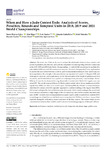When and how a judo contest ends: analysis of scores, penalties, rounds and temporal units in 2018, 2019 and 2021 world championships

Use este enlace para citar
http://hdl.handle.net/2183/33223Colecciones
- Investigación (CCDEF) [296]
Metadatos
Mostrar el registro completo del ítemTítulo
When and how a judo contest ends: analysis of scores, penalties, rounds and temporal units in 2018, 2019 and 2021 world championshipsAutor(es)
Fecha
2023-02-13Cita bibliográfica
Dopico-Calvo, X.; Mayo, X.; Santos, L.; Carballeira, E.; Šimenko, J.; Ceylan, B.; Clavel, I.; Iglesias-Soler, E. When and How a Judo Contest Ends: Analysis of Scores, Penalties, Rounds and Temporal Units in 2018, 2019 and 2021 World Championships. Appl. Sci. 2023, 13, 2395. https://doi.org/ 10.3390/app13042395
Resumen
[Abstract] Introduction: The main aim of this study was to analyse the relationship between how contests end
(scores or penalties), the temporal units and the competition rounds regarding when the contest end
in the 2018, 2019 and 2021 JudoWorld Championships. A total of 2340 contests involving 2244 elite
judo athletes (1343 men and 901 women) were analysed. Pearson’s chi-squared ( 2) was implemented
to analyse the association between variables, and the standardised residuals were used to analyse
its interpretation; the strength of the associations was reported as Cramer’s V. Shapiro–Wilk and
Kolmogorov–Smirnov were implemented to test the normality of the length of golden score (GS)
sequences, and Kruskal–Wallis was applied for analysing GS sequences by championships. Mann–
Whitney U was also implemented if a significant effect was detected. The level of significance was
set at 0.05. The results were as follows: (1) Most contests ended before the accomplishment of the
regular time (BRT), and they were won by ippon. (2) During BRT, the defeated accumulated more
shido than the winner, while the opposite happened in contests finishing at the regular time (FRT).
(3) Contests ending in the first and third minutes decreased, while contests ending in the second and
fourth minutes increased; a longer length of the GS period was observed for women compared with
men. (4) BRT contests were overrepresented in rounds 1 and 2, while extended time contests (EXT)
in repechage, semi-final, bronze and final were overrepresented. (5) There were fewer waza-ari than
expected during the preliminary rounds and more in the final rounds. The current study reveals
cornerstone information that could be used to improve the training programs of elite judo athletes.
Palabras clave
Performance analysis
Combat sports
Rule
Temporal unit
Phase
Stage
Golden score
Combat sports
Rule
Temporal unit
Phase
Stage
Golden score
Versión del editor
Derechos
Atribución- 4.0 Internacional
ISSN
2076-3417






